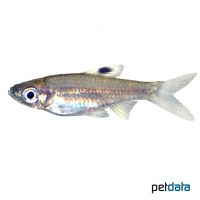Eyespot Rasbora (Brevibora dorsiocellata)
| Eyespot Rasbora Brevibora dorsiocellata | |
|---|---|
| Name | Eyespot Rasbora |
| Name Lat. | Brevibora dorsiocellata |
| Synonym | Rasbora dorsiocellata |
| Family | Danios |
| Family lat. | Danionidae |
| Order | Carps |
| Order lat. | Cypriniformes |
| Origin | Southeast Asia |
| Habitat | Forest streams, ponds |
| Diet | Carnivore |
| pH | 6.0-7.5 |
| Behavior | Peaceful |
| Keeping | Swarm |
| Care Level | Moderate |
| Reproduction | Egg scatterer |
| Breeding | Difficult |
| Life Span | 3-5 years |
| Protection | No |
| Metric Units | |
| Size | 3-4 cm |
| Temperature | 20-25 °C |
| Hardness | 5-12 °dH |
| Aquarium | 60 cm / 54 l |
| US Units | |
| Size | 1.2"-1.6" |
| Temperature | 68-77 °F |
| Hardness | 89-214 ppm |
| Aquarium | 15 gal |
Distribution and habitat
Eye spot danios are common in the tributaries of the Mekong River and the upper Chao Phraya River in northern Thailand and Laos. They live in the clear water of shady, slow-flowing forest streams and weedy pools.
Maintenance
The aquarium should have a dense border planting, with hiding and retreat possibilities (roots) and offer sufficient swimming space. In soft, slightly acidic water, subdued light (floating plants) and a dark substrate covered with some foliage (e.g. sea almond leaves) they show the most beautiful coloration.
No ammonia, ammonium and nitrite should be detectable, the nitrate value should not exceed 100 mg/l. To ensure the water quality and oxygen content, a filter and heater adapted to the aquarium size is required, as well as lighting for the species-appropriate day-night rhythm of the animals.
Diet
In nature they feed on insect larvae, small crustaceans, worms and other zooplankton. The food supply consists of live food, such as daphnia, cyclops, artemia, mysis and mosquito larvae, which are also well accepted frozen, plus commercially available frozen special food mixtures, supplemented with a high-quality, protein-rich dry food (granules, flakes, micropellets).
Only feed as much as is eaten immediately (in a maximum of 10 minutes). A regular and varied diet promotes health and increases resistance.
Behaviour and compatibility
They are lively and very peaceful schooling fish, well suited for a community tank with other small and peaceful fish. A group of at least 8 animals should always be kept together, but preferably more.
Basically, only compatible fish species with similar demands on water conditions and water temperature should be socialized.
Sex dimorphism
The slimmer male has an almost straight ventral line and a reddish caudal fin, while the female has a yellowish caudal fin and a rounded ventral line.
Reproduction and breeding
They are free spawners and spawn predators. The female spawns between fine-feathered plants (Java moss) near the bottom. The larvae hatch after 18-48 hours and swim freely after 1-2 days.
Fry must be fed several times a day with special rearing food (Artemia nauplii, dust food). In a community tank breeding is hardly possible, because the spawn is easy prey.
Important
The aquarium should be well covered, because they like to jump.
The foliage (sea almond tree, oak, etc.) not only provides cover, it enriches the water with humic substances, naturally lowers the pH and, when rotting, promotes the development of microorganisms, which are a valuable secondary food source.
The well-being of the fish should be monitored regularly. Temperature should be checked daily, pH, hardness and nitrate levels should be checked at least every 14 days. Regular partial water changes are recommended, even when contaminant levels have not yet reached the upper limit. Sudden changes in water quality should be avoided. Newly introduced fish must be accustomed slowly to the water in the aquarium.
Further literature can be found in your pet store.
References
Text: Sylvia Hos; Image: petdata
Source: BMELV (1998): Tierschutzgutachten - Haltung von Zierfischen (Süßwasser); RIEHL & BAENSCH (2006): Aquarien Atlas Bd. 1, Mergus Verlag; ENGELMANN (2005): Zootierhaltung - Tiere in menschlicher Obhut: Fische, Verlag Harri Deutsch
- Gemäß § 21 Abs. 5 Tierschutzgesetz idgF
